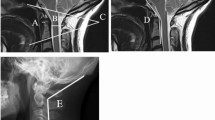Abstract
Purpose
Posterior fusion of the craniocervical junction (CCJ) has always been challenging in children with rare congenital diseases and malformations. At our institution, the introduction of the translaminar C2 screw technique led to a significant improvement in the quality of treatment.
Methods
Retrospective analysis of a pediatric cohort at a single institution who underwent CCJ posterior fusion between 2007 and 2018. Patients were divided into group 1 (other posterior fusion techniques, n = 12) and group 2 (translaminar axis screw placement, n = 19). Diagnosis, sex, age at surgery, surgical technique, immobilization, revisions, fusion, reduction, and complications were assessed.
Results
Follow-up ranged from 12 to 145 months (mean 50.7). The initial fusion rate detected at 3 months by CT differed significantly (66, 7% in group 1 vs. 100% in group 2, p = 0.018). Full reduction of C1/C2 malalignments was achieved in 41, 6% of group 1 versus 84, 2% of group 2 (p = 0.007). Immobilization was applied in 83, 3% of group 1 versus 26, 3% of group 2 (p = 0.0032). Ten complications were treated conservatively, and 15 events required revision surgery (80% in group 1 vs. 20% in group 2). Eight complications were related to immobilization.
Conclusions
The implementation of the translaminar C2 technique resulted in significantly more safety and efficiency regarding pediatric posterior fusion CCJ surgery at our institution, with significantly higher rates of rigid fixation, full reduction, and fusion, and significantly lower rates of complications and immobilization.
Graphic abstract
These slides can be retrieved under Electronic Supplementary Material.




Similar content being viewed by others
References
Menezes AH (2012) Craniocervical fusions in children. J Neurosurg Pediatr 9:573–585. https://doi.org/10.3171/2012.2.PEDS11371
Pang D, Thompson DN (2011) Embryology and bony malformations of the craniovertebral junction. Childs Nerv Syst 27:523–564. https://doi.org/10.1007/s00381-010-1358-9
Pang D, Thompson DN (2014) Embryology, classification, and surgical management of bony malformations of the craniovertebral junction. Adv Tech Stand Neurosurg 40:19–109. https://doi.org/10.1007/978-3-319-01065-6_2
Wright NM (2004) Posterior C2 fixation using bilateral, crossing C2 laminar screws: case series and technical note. J Spinal Disord Tech 17:158–162
Wright NM (2005) Translaminar rigid screw fixation of the axis. Technical note. J Neurosurg Spine 3:409–414
Park H, Byeon HK, Kim HS, Hong JJ, Suk KS (2017) Odontoid osteomyelitis with atlantoaxial subluxation in an infant. Eur Spine J 26(Suppl 1):136–140
Skaggs DL, Lerman LD, Albrektson J, Lerman M, Stewart DG, Tolo VT (2008) Use of a noninvasive halo in children. Spine (Philadelphia, Pa.: 1976) 1(33):1650–1654
Cristante AF, Torelli AG, Kohlmann RB, Dias da Rocha I, Biraghi OL, Iutaka AS et al (2012) Feasibility of intralaminar, lateral mass, or pedicle axis vertebra screws in children under 10 years of age: a tomographic study. Neurosurgery 70:835–838. https://doi.org/10.1227/NEU.0b013e3182367417
Geck MJ, Truumees E, Hawthorne D, Singh D, Stokes JK, Flynn A (2014) Feasibility of rigid upper cervical instrumentation in children: tomographic analysis of children aged 2-6. J Spinal Disord Tech 27:E110–E117
Tan GH, Goss BG, Thorpe PJ, Williams RP (2007) CT-based classification of long spinal allograft fusion. Eur Spine J 16(11):1875–1881
Iyer RR, Tuite GF, Meoded A, Carey CC, Rodriguez LF (2017) A modified technique for occipitocervical fusion using compressed iliac crest allograft results in a high rate of fusion in the pediatric population. World Neurosurg 107:342–350. https://doi.org/10.1016/j.wneu.2017.07.172
Yang BW, Glotzbecker MP, Troy M, Proctor MR, Hresko MT, Hedequist DJ (2018) C2 Translaminar Screw Fixation in Children. J Pediatr Orthop 38:e312–e317
Singh B, Cree A (2015) Laminar screw fixation of the axis in the pediatric population: a series of eight patients. Spine J 15:e17–e25. https://doi.org/10.1016/j.spinee.2014.10.009
Acknowledgements
We are very thankful to Kara Krajewski for proofreading and editing the English manuscript.
Author information
Authors and Affiliations
Corresponding author
Ethics declarations
Conflict of interest
The authors report no conflict of interest concerning the materials or methods used in this study or the findings specified in this paper.
Additional information
Publisher's Note
Springer Nature remains neutral with regard to jurisdictional claims in published maps and institutional affiliations.
Electronic supplementary material
Below is the link to the electronic supplementary material.
Rights and permissions
About this article
Cite this article
Hagemann, C., Stücker, R., Schmitt, I. et al. Posterior fusion of the craniocervical junction in the pediatric spine: Wright’s translaminar C2 screw technique provides for more safety and effectiveness. Eur Spine J 29, 970–976 (2020). https://doi.org/10.1007/s00586-020-06368-w
Received:
Revised:
Accepted:
Published:
Issue Date:
DOI: https://doi.org/10.1007/s00586-020-06368-w




